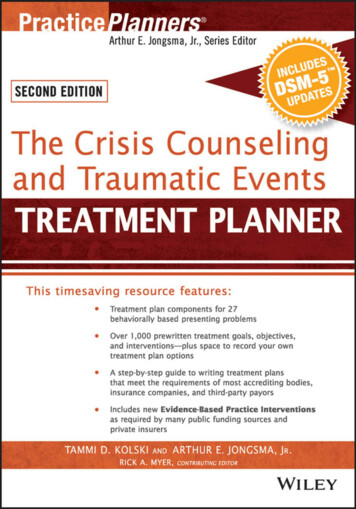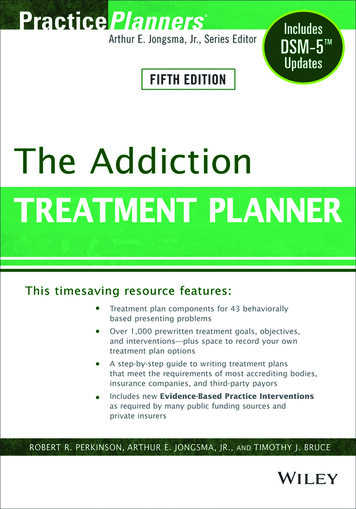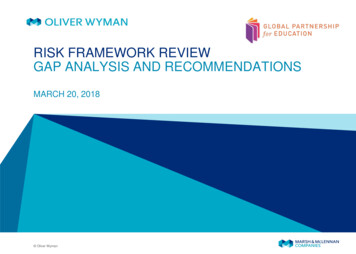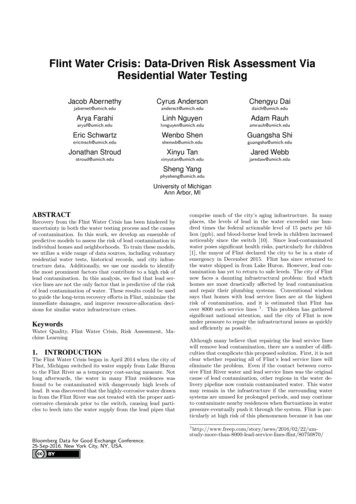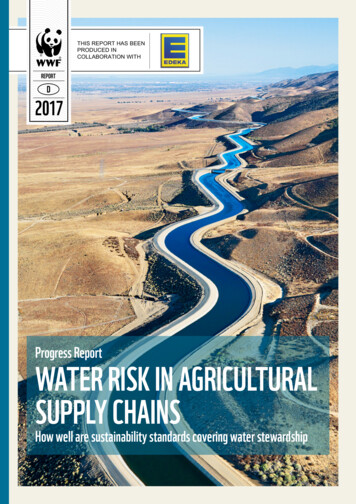
Transcription
THIS REPORT HAS BEENPRODUCED INCOLLABORATION WITHREPORT2017Progress ReportWATER RISK IN AGRICULTURALSUPPLY CHAINSHow well are sustainability standards covering water stewardship
ContentsISBN 978-3-946211-12-9PublisherDateLead F GermanyOctober 2017Alexis Morgan (WWF International)Philipp Wagnitz, Johannes Schmiester (WWF Germany)Alexis Morgan (WWF International), amorgan@wwfint.orgPhilipp Wagnitz (WWF Germany), philipp.wagnitz@wwf.deAnna RischSven Ortmeier (WWF Germany) iofoto (GettyImages), Robert Günther (WWF), Sonja Brüggemann, Nicole Harrington(Unsplash), Phillip Wagnitz (WWF), Levi Morsy (Unsplash), Philip Swinburn (Unsplash)Many thanks to the following contributors: Jörg-Andreas Krüger (WWF Germany); Enrique Uribe(Global GAP); Adrian Sym (AWS); Thomas Köberich (WWF Germany); Katrin Oswald (WWF-Switzerland);Lindsay Bass, Franklin Holley and Alex Bjork (WWF-US); Cotton Made in Africa/ABT Foundation (AlexandraPerschau); Fairtrade (Gelkha Buitrago); Global Organic Textile Standard (Rahul Bhajekar and Sumit Gupta);ISCC (Lydia Pforte); Naturland (Alexander Koch and Martin Weber); Roundtable on Responsible Soy(Jimena Frojan and Daniel Kazimierski); Sustainable Agriculture Network (Oliver Bach); Utz (Britta Wyss,Jefferson Andrade and Lenneke Braam). Finally, we would like to acknowledge the input of various reviewers ofthis report and its assessment, those involved in its publication, as well as its funders.This report should be cited as:Morgan, A. J. (2017) Water risk in agricultural supply chains: How well are sustainability standards covering waterstewardship – A Progress Report, WWF Germany, Berlin.Message from the Chief Conservation Officer of WWF German 4Message from the Head of Corporate Communications of EDEKA 5Executive Summary 61Introduction 82Methodology 103Results: reviewing the current coverage of water stewardship 153.1 Overall water stewardship coverage 153.2 Comparing water stewardship coverage between conventional and organic standards 183.3 Comparing the progress in standards that have been updated since 2015 184Discussing solutions and exploring ideas 234.1 Part A – Agricultural Sustainability Standard Systems 234.2 Part B – Companies with Significant Agricultural Supply Chains 275Conclusion 31Annex 32Annex A: Select Best Practice Examples 32Annex B: Water Stewardship Assessment Framework 34Annex C1: Coverage of water stewardship elements by select conventionalagricultural sustainability standards 40Annex C2: Coverage of water stewardship elements by select organicagricultural sustainability and other standards 42List of Abbreviations 43List of Figures, Tables and Boxes 43Footnotes 43
Message from the ChiefConservation Officerof WWF GermanyIdentifying major risks linked to sourcing and production is the first step ofa responsible supply chain management for any company. For some sectors,water stands on top – and presents a clear business case. In the food retail sectorof Germany, every Euro earned consumes around 47 liters of water, followedby apparel retail with around 14 liter per Euro . The link does not astonish, asagriculture accounts for 70% of the worlds freshwater consumption. How diredroughts or floods can impact the bottom line can be seen in high frequency incountries such as Australia, India, Pakistan, Egypt, Morocco, South Africa, Spain,USA, Peru – to name but a few. But does this change?As global freshwater consumption (and associated challenges) is expected torise by 40% in the next decades, we should fundamentally question the way wethink. As the United Nations Sustainable Development Goals put it, we needto shift our thinking from increasing water efficiency in agriculture(e.g. “more crop per drop”) to sustainable withdrawals of waterwithin the boundaries of a river basin. Only then we will be able to addressthe root causes of the shared water challenges of economies, people, nature andgovernments that ultimately result in water scarcity, pollution or floods.Agricultural certification schemes function as major supply chain managementtool for retailers and farmers but often still do address the topic reasonably.In 2015 we benchmarked 17 conventional and 4 organic agricultural standardsagainst what we consider comprehensive water criteria for standard systems.Since then much has happened. Systems have adopted more sophisticated watercriteria and started open dialogues around the topic. By extending the range ofsystems analyzed, showing progress actionable pathways, we hope to contributeto a better consideration of shared nature of water in agricultural standardsystems.Message from the Head ofCorporate Communicationsof EDEKAResponsibility and sustainability are well-established values in the way EDEKAis trading. In the long-term strategic partnership with WWF, EDEKA is beingadvised on a variety of sustainability areas with the objective to reduceEDEKA’s ecological footprint, expand its range of more sustainable productsand raise consumer awareness for these products as well as sustainableconsumer habits.Population growth, changing global consumption patterns and impacts of climatechange are increasing the pressure on the world’s freshwater resources with agri culture remaining the world’s biggest water user. EDEKA and WWF acknowledgethe importance of this issue, assess products’ water risks and engage in projectswith agricultural producers to reduce these risks. In the future, a leap towardsmore systemization of these efforts will be made by the establishment of aninternal water management system for EDEKA.In the light of diverse food supply chains, standards can play a key role infostering a more sustainable water use in agriculture. Standards are neededthat go beyond the farms’ fence lines and adopt aspects of waterstewardship, i.e. a context and multi-stakeholder perspective.Therefore, EDEKA is very pleased to support this sequel of 2015’s study thatshows the standard landscape’s recent developments. Our food productiondepends on the state of the world’s freshwater resources – we need to use watermore sustainably within and beyond our fence lines.Rolf Lange,Head of Corporate Communications EDEKA AGJörg-Andreas KrügerChief Conservation OfficerWWF Germany4Water risk in agricultural supply chains 5
Executive SummaryThe world’s water challenges are, to a large extentthe world’s sustainable food production challenges.Recognizing this, many of the world’s largest food,beverage and retail companies have started to engage their supply chains in aneffort to mitigate their biggest water risks. Voluntary agricultural sustainabilitystandards, programs, tools and certification schemes (or agricultural sustainability standards1 as they will be broadly referred to in this report), which offerconsistent, verifiable approaches that can be broadly rolled out with confidence,are one key approach that companies have employed to deliver on sustainablesourcing commitments, including addressing water concerns. However, thedegree of coverage on water issues by various agricultural sustainability standards varies considerably. Indeed, traditionally many agricultural sustainabilitystandards have restricted water criteria to efficient use and minimizing both soilerosion and nutrient runoff. As the collective understanding of water stewardshiphas emerged, there has been a growing appreciation that it takes more thanon-site action to adequately mitigate basin and operational water risks.Organic standardshave weaker This report assessed 25 different agricultural sustainability standards andcoverage compared represents a follow up on a report published in 2015. The analysis shows severalto conventional key conclusions:agricultural sustai- »» Of the four water stewardship outcomes, water quality continues to bethe best covered aspect of water stewardship, followed by water balance,nability standards.important water-related areas and governance.»» The most consistently well-covered issues are: water efficiency, effluentmanagement and legal compliance»» Conversely, participation in water governance, indirect water useassessment, collective action, climate change resilience and aquatic invasive species remain the most poorly covered issues.Looking ahead, we offer the following recommendations for agricultural sustainability standard systems:1. Develop supplementary water stewardship guidance and training2. Integrate water stewardship into standard requirements, including addressinggaps/missing elements, strengthening wording to create more robustrequirements 2, exploring new and progressive concepts, and complementingefficiency measures with cumulative basin impact approaches3. Enhance standard systems collaboration, via mutual recognition,add-ons, and service provisionFurthermore, for companies with significant agricultural supply chains,we offer the following recommendations:1. Know your water risk and use credible standards, but make sure the standardsyou employ are fit for purpose as you seek to mitigate your water risks2. Accelerate sector collaboration to advance water stewardship in standards3.Engage and disclose on water stewardship in agricultureWater stewardship remains a material concern to companies and investorsthat largely manifests in agricultural supply chains. Without a strong response,communities, nature and business interests all suffer in the long term. The useof agricultural sustainability standards, when accompanied by robust waterstewardship requirements, offers a pathway to address this concern. Adopting therecommendations above, we believe that standards can be a powerful mechanismto achieve stronger farming systems for the planet and people alike.»» The ongoing lack of coverage of core concepts in water stewardship(e.g. collective action, water governance and consideration of future waterrisks) suggests that for most agricultural sustainability standards, there is stilla lot of room for improvement.»» Organic standards have comparable coverage in the four water stewardshipoutcomes in terms of water quality, but generally have weaker coverageof water balance, water governance and important water-relatedareas when compared to conventional agricultural sustainability standards.»» Modest, but positive, progress has been made since 2015 in includingwater stewardship elements in those standards that have been updated.The overall takeaways for all audiences are: water stewardship integration beginswith a deeper understanding of your context and agricultural water risks, besure you are considering collective actions and engagement in water governance,ensure efficiency requirements are supplemented with cumulative basin impactconsiderations, and collaborate as much as possible.6Water risk in agricultural supply chains 7
1IntroductionThe world’s waterchallenges are toa large extent, theworld’s sustainablefood productionchallenges.Figure 1: Global IrrigatedLand Facing Water RiskSource: WWF Water RiskFilter (http://waterriskfilter.panda.org/)It is well recognized that agriculture accounts for anestimated 70 percent of global water use, and up to90 percent of global water consumption3. Furthermore, the vast majority of the disruptions to global biogeochemical (i.e. nutrient)cycles stem from fertilizer use to increase crop production. The world’s waterchallenges are in large part, the world’s sustainable food production challenges.Conversely, so too are the world’s crops facing water risks (Figure 1). As companiesincreasingly recognize the growing water challenges, they have sought to improvethe sustainability of their procurement and supply chains. Much of this push hascome via “sustainable supply chain” or “sustainable procurement” commitments,in turn enabled through the use of third-party certified sustainability standards.As this happens, it is important to understand the extent to which a given standardcovers the various water risks that exist, for example, would use of standard X helpto mitigate the physical (e.g. droughts, floods, water quality impacts or depend encies), regulatory (e.g. weak regulation, weak enforcement) or reputational(e.g. water conflicts) risks being faced.WWF’s mission is to stop the degradation of the planet’s natural environment andto build a future in which people live in harmony with nature. With freshwaterspecies declining at a rate faster than any other4, the need to address freshwaterconservation through sustainable food systems has never been greater. WWF hashad a long history of engagement in sustainability standards for select commodities in an effort to use the power of markets to drive sustainable outcomes. Withthese elements in mind, WWF published a report in 2015 entitled “StrengtheningWater Stewardship in Agricultural Standards.“That report provided an evaluation framework that covered water stewardshipaspects across four primary outcome areas. The framework and outcomes were acombination of WWF’s Certification Assessment Tool (CAT) and the most widelyrecognized synthesis of water stewardship thinking, codified into the Alliancefor Water Stewardship Standard. The report explored 23 different standards andguidance documents concluded that while areas, such as effluent management,legal compliance, freshwater habitat management and water, sanitation andBOX A: Shifting landscape of certificationCertification can be an expensive proposition for many retailers and producers.Over the years, WWF has heard numerous concerns raised over the cost ofcertification, especially as standards began to proliferate. Over the past few years,we have noticed a shift by several larger Global 500 companies, including Unilever,Sainsbury’s, and others to begin to develop internal supplier codes of conductthat eschew third party multi-stakeholder standard systems in favour of in-houseauditing schemes.As this trend continues, it creates its own challenges. For example, for farmers orother producers who supply multiple clients, having to handle multiple systems iseven more burdensome and costly than a single third party standard.The Sustainability Consortium (TSC) has begun to track, and compile an understanding of how sustainability supplier requirements are emerging, and to understand how these might be consolidated into a more unified “code”. No matter what,it will be important to ensure rigorous mechanisms are maintained to ensure strongsustainability performance (i.e. monitoring and evaluation of impacts, independentassurance) remains at the heart of any system.The report isexplicitly not tryingto rate which are hygiene (WASH) were reasonably well covered by many standards, importantthe “best” or other concepts such as collective action or action in water governance, climateresilience, or responding to freshwater invasive species were rarely or“worst” standards changepoorly addressed. Finally, four key recommendations emerged from the report:when it comesurther enhance the integrated water stewardship assessment frameworkto water. 1. Fanddevelop common guidance on water stewardship2.3.4.Encourage standards interoperability with respect to freshwater. xplore opportunities for mutual recognition and collaboration amongEcommodity standards. teadily continue to strengthen water stewardship related requirements inSstandards to help mitigate water risksThis report aims at evaluating the progress in various standards over the last twoyears. Furthermore, the report expands the coverage to an additional 6 standardsand also provides guidance to two audiences: (1) standard systems on how tofurther integrate water stewardship concepts into their systems and (2) companieson how to ensure that the standards they use to address water risks in theiragricultural supply chains are fit-for-purpose.Like the 2015 report, the new report is explicitly not trying to rate which are the“best” or “worst” standards when it comes to water. Every standard has a nicheand role to play. Where a commodity (or a given growing region) is at lower waterrisk, stronger water criteria are likely not a priority and this study backs suchdistinctions. However, for commodities and regions facing higher water risk,a lack of water stewardship coverage may result in greater losses from water risks(for farmers and their buyers). Therefore the intention is to help standard users(i.e. growers) mitigate water risks, where exposure is an issue. Lastly, it is important to note that this report is not evaluating water impacts (or performance),nor assessing the broader system (e.g. governance, implementation and assurance mechanisms, which can be seen as a proxy for the credibility of a scheme),but rather focuses explicitly on standard requirements related to water.8Water risk in agricultural supply chains 9
2MethodologyThis report draws upon a similar methodology andframework as the 2015 report. The original reportincluded 23 agricultural sustainability standardsystems based on popular use, and the interests of WWF and Edeka.This 2017 study returned to many of these standards, but opted to drop severaland add several new standards. More specifically, this study included an additional five new standards to bolster an understanding of organic standards andcover two other agricultural standards that were not addressed before: USDAOrganic (USDAO), Global Organic Textile Standard (GOTS), China OrganicStandard GB19630.1-4—2005 (COS), International Sustainability and CarbonCertification (ISCC), Linking Environment and Farming Standard (LEAF)Conversely, we opted to drop the earlier SAI standards (F&V, SWM, and WS)since they have largely been replaced by the SAI FSA tool, which, while nottechnically a standard, is used as a benchmarking tool amongst standards.Similarly, the GRSB, which provides principles but not a standard as such(e.g. lacks criteria and indicators) was also dropped. Lastly, it was felt that theFairtrade Standard for Hired Labour was a better like-for-like comparisonthan the Standard for Small Producer Organizations, so this has been switched,leaving a total of 25 standards, as follows:1. AWS: Alliance for Water Stewardship – AWS International WaterStewardship Standard, v 20142. ASC: Aquaculture Stewardship Council – ASC Tilapia Standard:Version 1.0 January 20123. BCI: Better Cotton Production Principles & Criteria, 2017 Draft, v24. BON: Bonsucro Production Standard Including Bonsucro EU ProductionStandard, Version 4.2 December 20165. CmiA: Cotton made in Africa – Criteria Matrix Version 3.1 - 15.02.20156. Fairtrade Standard for Hired Labour, 15.01.2014 v1.37. GCP: Global Coffee Platform – GCP Doc 01 Baseline Common Code v2.1 en8. GGAP: Global.G.A.P. Integrated Farm Assurance – All Farm Base,Crops Base, Fruit and Vegetables, English Version 5.1, July 20179. GOTS: Global Organic Textile Standard version 5.010. ISCC : International Sustainability & Carbon Certification –ISCC PLUS version 3.0 09 February 201611. LEAF: Linking Environment and Farming – LEAF Marque Standardversion 14.112. PT: The ProTerra Standard – Version 3.0 – Approved Dec 28 201413. RSB: Roundtable for Sustainable Biomaterials – RSB Principles & Criteriafor Sustainable Biofuel Production, RSB-STD-01-001, Version 3.014. RSPO: Roundtable for Sustainable Palm Oil – RSPO Principles and Criteriafor Sustainable Palm Oil Production 201315. RTRS: Round Table on Sustainable Soy – RTRS Standard for ResponsibleSoy Production Version 3.1, June 1, 201716. SAI-FSA: Sustainable Agriculture Initiative – SAI Platform FarmSustainability Assessment 2.017. SAN: Sustainable Agriculture Network – SAN-S-SP-1-V1.2 SAN SustainableAgriculture Standard July 201718. SRP: Sustainable Rice Platform – Standard on Sustainable Rice CultivationVersion 1.019. Utz: Utz Core Code of Conduct (Version 1.1, For individual and multi-sitecertification, 2015) Coffee Code of Conduct (Version 1.1)20. EU-O: European Organic Regulations (Plant & Livestock – (EC)No 834/2007, 889/2008 & 1235/200821. USDA-O: USDA Organic Standards22. IFOAM: International Federation of Organic Agriculture Movements –The IFOAM NORMS for Organic Production and Processing Version July 201423. NAT: Naturland Standards on Production – Version 05/201724. BIO: Bioland Standards as of November 22, 201625. OFDC-O: China Organic Standard – OFDC Organic Certification Standards,September 1, 201610Water risk in agricultural supply chains 11
Score and colour codeScore 0Score 1Score 2Score 31.Water Governance and Management1.1Legal Compliance1.2Land and Water Rights (Indigenous Peoples’ Rights, Traditional Use Rights,including free, prior and informed consent where applicable)1.3Water risk & context I: Consideration of catchment dependencies1.4Water risk & context II: Consideration of catchment impacts (Environmental andSocial Impact Assessment)1.5Adaptive water management plan or policy ideally backed by leadership commitment1.6Transparency, Disclosure and Stakeholder Consultation1.7Dispute ResolutionGeneral fulfilment of criterion (limited gaps)The standard explicitly addresses the framework criterion, and includes sufficient detailto give confidence in effective and consistent implementation, but it is still limited in somemanner (often not providing water-specific elements). In many cases a score of2 indicates coverage that could be further improved.1.8Catchment-level collaboration / Collective Action1.9Consideration of Indirect Water Use and supply chain engagement1.10Future Scenario & Resilience Planning1.11Water, Sanitation and Hygiene for staffSubstantive fulfilment of criterion (very limited/no gaps)The standard substantively and comprehensively addresses the framework criterion,often with water-specific references, and includes sufficient detail to give confidence ineffective and consistent implementation. A score of 3 often represents a leading exampleof how to ensure water is explicitly covered, and where improvements could be madeto requirements scoring a 3, they tend to be minor adjustments.1.12Catchment governance and policy engagement2.Water Balance2.1Quantitative water use information (environmental flow, water use, net withdrawal,monitoring)2.2Water use efficiency2.3Absolute or contextual water quantity limitations (surface and groundwater)3.Water Quality Status3.1Qualitative water use information (indicators, monitoring)3.2Effluent management: fertilizer, pesticides, soil management/ erosion, wastemanagement3.3Absolute or contextual water quality limitations4.Important Water Related Areas4.1Management of Riparian, Wetland and other Water-related Habitat Areas4.2Management of Water-related Areas of Religious, Cultural or other Social Importance4.3Water-related Land Use Conversion (past and future) and restoration4.4Rare, Threatened and Endangered Freshwater Species4.5Aquatic invasive speciesGrade and descriptionNo significant fulfilment of criterionThe standard has no explicit elements that would be expected to make a significantcontribution to the framework criterion, or elements may be mentioned in an extremelyvague way, with no indication that applicants would in practice be expected to take actionto address the issue.Limited fulfilment of criterion / indirectly referenced (significant gaps)The standard addresses limited elements of the framework criterion, but also misses outsome significant elements; indirectly references or addresses the criterion but withoutgiving enough detail to give confidence of consistent implementation; or, addresses themain elements of the framework but in a way that even in the long term compliance isvoluntary.Table 1: Scoring system for water stewardship coverageFurthermore, some minor revisions were made to the framework including dropping “water as a priority area” as it was seen as redundant. Furthermore, severalareas were merged. These included incorporating the leadership commitmentinto the adaptive management plan, including water risk assessment with catchment context, and combining ecosystem services with management of habitats.Lastly, the past two years has also seen increasing alignment between the aspectsof this framework with WWF’s Certification Assessment Tool (version 4.0).In general, the assessment employs a liberal interpretation of standards sincemany standards do not make all criteria mandatory (e.g. a minor/major system,a temporal step-wise approach with increasing requirements in future years,a scoring system with choices, etc.) This means that in some cases standardsmay not cover water stewardship issues as well as this report denotes, though intheory they could do so.Some casesstandards maynot cover waterstewardship issues,though in theorythey could do so.12Table 2: Summarized version of the Water Stewardship Assessment FrameworkThe 0-3 point scoring system (Table 1) remains the same. The primary aim of thescoring is to denote whether the issue is covered at all (0), whether it is mentioned or alluded to but in a very weak or limited manner (1), covered but eithernot strongly or not explicitly referencing water (2) or covered well and tied towater (3). Table 2 provides a summary of the different aspects that were evaluated (see Annex B for full details of the assessment framework).Water risk in agricultural supply chains 13
Not all standards have completed a full revision since the publication of the2015 report. Table 3 outlines the status of the standards in this report as ofSeptember 2017 (with revision years noted in brackets).All standards, regardless of their revision status, were re-scored to ensure consistency and to account for the minor adjustments in the framework. Note that inso doing, a few scores from the 2015 report were adjusted to reflect changes inthe framework and interpretation. However, the majority of the adjusted scoresreflect changes in the actual standard criteria.Scores were initially determined by WWF, and then provided to the Standardholders for the opportunity to review and comment before the assessment wasfinalized.Updated(Year of last update)Presently under revision(Last update /Revision year)Not yet updated /not scheduledBioland (2016)ASC (2012 / 2017)CMiA (2015 / NA)Bonsucro (2016)AWS (2014 / 2017)Fairtrade (HL) (2014 / 2019)Global G.A.P.(2017)BCI* (2014 / 2017)IFOAM (2014 / NA)GCP (formerly 4C) (2016)RSPO (2013 / 2018)ProTerra (2014 / NA)GOTS (2017)3RESULTS: reviewing thecurrent coverage of waterstewardship3.1 Overall water stewardship coverageThe summarized performance of the standard systems by water stewardshipoutcome may be seen in Figure 3 below, with the full results available inAnnex C1 and C2. The spider diagram is helpful to interpret a number of trendsvisually (water stewardship coverage is stronger as one moves out from thecenter), including:Organic standards Ascore much weakerin water balance, Bwater governance,and important Cwater-related areas.DISCC Plus (2016)LEAF (2017)Naturland (2017)RSB (2017)RTRS (2017)SAN (2017)SRP (2015)ESAI (FSA) (2015)Utz (2015)Table 3: Standards updates since 2015* BCI was an exception as it is near publication and the updated, draft version was used inthis assessment. Differences between the agreed upon version may differ from the resultspresented in this study.FG14 ll of the standards address at least one or more of the water stewardshipAoutcomes There is a stronger coverage (yellow line, further to the outside) of waterquality here is weaker coverage (red line, closer to the center) associated with waterTgovernance and management. here is a high level of variation in coverage of water stewardship outcomesTbetween standards meaning that certain standards have greater coverage(lines further to the outer perimeter) or lesser coverage (lines closer to thecenter) than other standards (e.g. RSB as compared to USDA Organic). Ofthe outcomes, water balance is perhaps the most variable as seen with severalsystems in which the blue line is located towards the center (e.g. EU Organic,USDA Organic, ASC), indicating weaker coverage, while others (e.g. RSB,Naturland and Bonsucro) have the blue line closer to the perimeter indicatingstronger coverage. here is also a high level of variation in coverage of water stewardship outTcomes within most standards (e.g. ASC, Global G.A.P., LEAF), though thereare a few that perform quite consistently (e.g. AWS, ISCC Plus). This meansthat for any given standard, there is often considerable variation in whetherit covers any one of the given stewardship outcomes (e.g. GOTS which hasreasonably strong coverage of water quality, but weak coverage of watergovernance). hile the organic standards (top left) tend to score comparably in terms ofWwater quality coverage, but are, in general, weaker in terms of their coverage of water balance, water governance and management, and importantwater-related areas. astly, for Europe, there is also a notable difference between public organicLstandard (EU Organic) and the independent organic standards (e.g. Naturland, Bioland).Water risk in agricultural supply chains 15
Water Stewardship Coverage by Outcome Across Assessed StandardsFigure 2: Water Stewardship Coverage by Outcome Across Assessed Standards1. Water Governance and Management2. Water Balance3. Water Quality4. Important Water Related AreasTable 4: Coverage of water stewardship issues in assessed conventional agricultural standardsAWSUSDA Org3,0ASCNaturland (Org)Well coveredPoorly coveredBON2,0IFOAM (Org)CMiA1,51,0EU Org1.5 Water management plan (1.8)3.1 Qualitative water use information (1.8)4.4 Rare, Threatened &Endangered freshwater species (1.6)1.3 Catchment context (1.6)3.3 Absolute water quality limitations (1.6)1.2 Land and water rights (1.6)2.1 Quantitative water use information (1.6)1.6 Transparency & Stakeholder engagement (1.4)2.3 Absolute quantitative water use limitations (1.4)1.7 Dispute resolution (1.3)4.2 Management of water-relatedsocio-cultural areas (1.3)1.4 Environmental & Social Impact (1.2)4.51.81.91
Agricultural certification schemes function as major supply chain management tool for retailers and farmers but often still do address the topic reasonably. In 2015 we benchmarked 17 conventional and 4 organic agricultural standards against what we consider comprehensive water criteria for standard systems. Since then much has happened.




